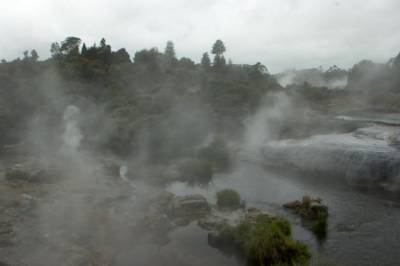Geothermal Activity
We left the Coromandel Peninsula on Sunday with a bit of sadness. It was so gorgeous, yet we got to see so little of it. It sounds so corny, but it is as if John gave us a great gift by sharing this special place with us. It has been raining the past two days and Hart and I are both eager to get to the south island, so we rushed our stay in the Coromandel to use the rainy days as travel days.
Sunday's main stop was in Rotorua, which our guidebook describes as "one of the world's most concentrated and accessible geothermal areas." The heat from the water boiling underground and the presence of sulfur make the landscape look almost like a barren moonscape. Plantlife does survive, but the bottom layers of any plant near the ground or water surface has been killed by the heat. From about 15 kilometers away from Rotorua, the rotten-egg smell of sulfur drifts in. The closer you get, the stronger the smell -- Hart and I both wound up with headaches and nausea from the odor. It was worth it to see boiling mud pools, steaming streams and puddles of water, and geysers shooting from the ground.

In addition to the stunning natural features of the area, Rotorua is also considered the place wherein the history and tradition of New Zealand's first settlers, the Maori, is most intact. Hart and I went to the New Zealand Maori Arts and Crafts Insitute to see the thermal features and learn about Maori culture. We were too late to see any of the shows, but did see beautiful carvings and tools. The institute was created by a Maori man who wanted to ensure that Maori children would be taught about their heritage, thus keeping Maori cultural knowledge alive.
0 Comments:
Post a Comment
Subscribe to Post Comments [Atom]
<< Home